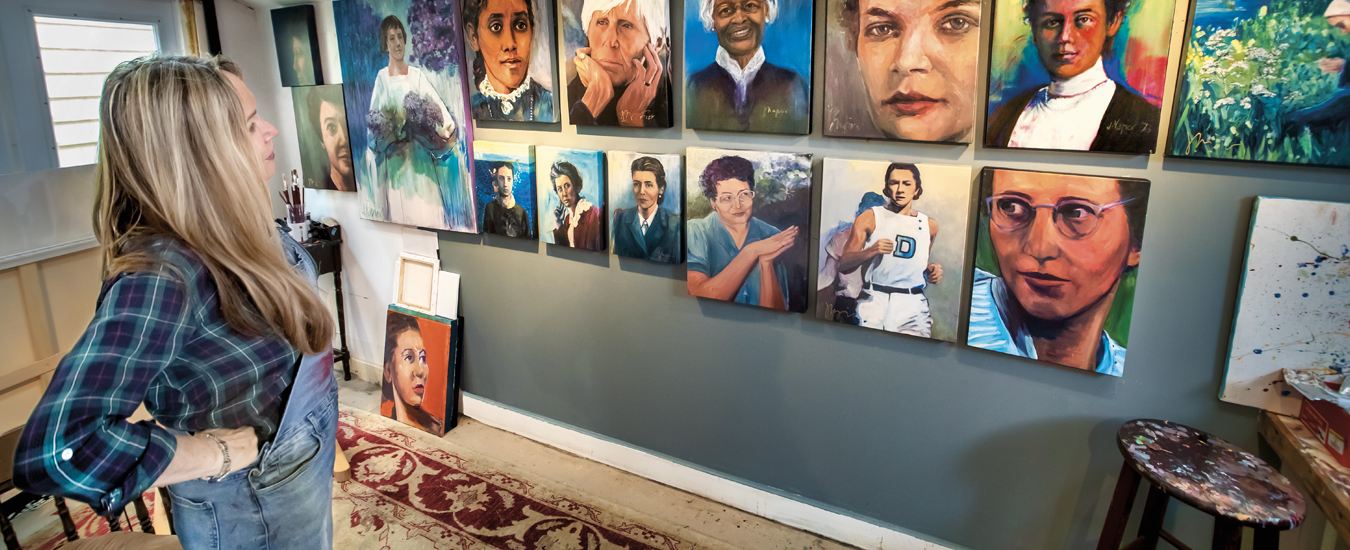Jo Napier always thought writing was her thing until she picked up a paintbrush. It was after she’d finished writing a book on how women were reshaping the digital landscape.
Once she finished the manuscript, she left Toronto to spend the summer at home in Halifax, where her mother urged her to tag along with her to a painting course in nearby Fall River, Nova Scotia.
“My mother wisely said, ‘You’re done on Friday. Make sure on Monday, you’re busy,” says Napier, who started her career writing for the Chronicle Herald and went on to become a columnist for the Globe and Mail and the Ottawa Citizen.
Jeannie Hancock ran the workshop. She’s a Nova Scotian painter and artist who studied under Arthur Lismer, a founding member of the Group of Seven and principal (1916 to 1919) of what would later become the Nova Scotia College of Art and Design, (now NSCAD University).
“It wasn’t like a teaching class,” says Napier. “It was all old women and they were amazing. They all had such a sense of who they were and what their art was about. I had my chance to paint in this really rich environment. It was women stepping into the cool of their ability.”
Hancock had them do three or four paintings in one day.
“You didn’t have time for your conscious mind to step in and get judgemental. You just did it,” says Napier. “I never felt anything like it. Even talking about it now, I’m tingling. It was crazy how alive I felt.”
She carried on with her writing career for another seven or eight years before switching to painting full time when her daughter, Julia, who is now 17, was born.
“I remember writing a note to myself and posting it on the fridge and it said, ‘Holy drudgery.’ I always wanted to be a mother. I was so grateful to be a mom and have this time with my daughter. But I’d never been home before. Dishes, laundry, meals. It had never been my life before. I needed to develop another side to myself.”
Lying in bed with her daughter and reading her stories sparked a new artistic outlet for Napier.
“I was reading Caillou and Curious George and I thought, ‘This is a powerful teachable moment. I should be using a little of this time to tell her about great women from Nova Scotia. Inspire her, educate her,’” says Napier. “After a good 10 years in the Herald newsroom, I couldn’t think of one from Nova Scotia. I kind of thought of Rita Joe but I didn’t quite know who she was. I knew she was Mi’kmaw. I knew she was a writer. I didn’t have any great story to tell about her.”
She used that ignorance as an opportunity.
She went down to the library on Spring Garden Road and left a note for Norma, a reference librarian who’d helped her with the book on women in technology, asking for suggestions on great women of Nova Scotia.
“She was on vacation, but it turns out if you leave a note like that for female librarians, it’s like catnip,” says Napier.
“There’s all this untold female history that they’re so aware of and there’s no outlet for it.”
She got a note back with 25 names. “Maybe two or three were vaguely familiar, but I couldn’t have done a proper bio on any of them.”
She winnowed down the list and started researching the women and painting large-scale, contemporary portraits with a high-colour palette, without the attention to detail seen in some art.
Two years later, in 2011, she rented space at the Nova Scotia Archives and had her first show of work, the Nova Scotia Nine.
Royal Bank of Canada bought the portraits of midwife and homesteading pioneer Granny Ross, peace activist Muriel Duckworth, and others for its national collection.

Napier expanded her repertoire when her daughter got older and wanted to turn the coat closet into a science lab. She says that she realized she couldn’t think of any women of science besides Marie Curie, and set out to change that.
She started the Great Women Portrait Project and has gotten commissions and sponsorships for paintings of historic women from the likes of Lockheed Martin Canada, Sanofi Pharmaceuticals, and Dalhousie University.
“What I’m trying to do is create a constellation of women who want to honour women’s history and educate this generation and inspire the next by showing the hidden history of women,” she says.
She only paints historic women. “I always figure living women can market themselves,” she says.
Rather than being careful about drawing, she’s more interested in colour and capturing and conveying the spirit of the person she’s painting.
Her father was instrumental in her learning to paint fearlessly and with confidence. While he was working as an outport doctor in Bonavista, N.L., his way of relaxing was to come home and paint a long mural in the living room. “My mother, interestingly enough, let him do it,” Napier says.
She remembers the mural as a panorama of people, in a Norman Rockwell, everyday-life style, with life-size people from all over the world.
“You’d slowly see this Arab man, an Asian woman, elbow, earlobe, hair evolving. I was this little girl, and I just loved it.”
Napier doesn’t see the appetite for her work diminishing as diversity, equity, and inclusion efforts face a backlash.
“The real thing I’ve discovered with this project is that women are hungry for their history,” she says.
“When there’s a genuine hunger there … that gets fed.”
